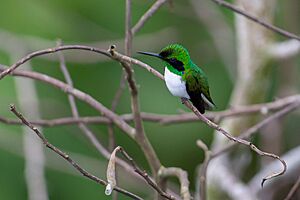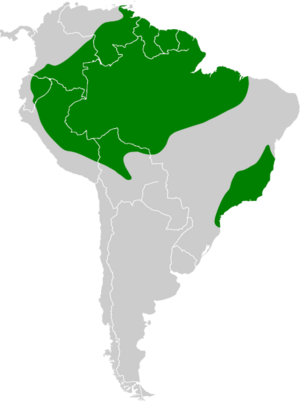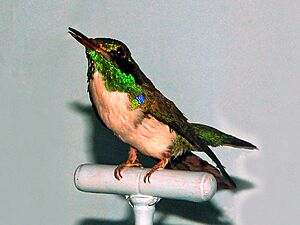Black-eared fairy facts for kids
Quick facts for kids Black-eared fairy |
|
|---|---|
 |
|
| Conservation status | |
| Scientific classification | |
| Genus: |
Heliothryx
|
| Species: |
auritus
|
 |
|
The black-eared fairy (scientific name: Heliothryx auritus) is a tiny, colorful hummingbird. It belongs to a group of hummingbirds called Polytminae. You can find this amazing bird in many parts of South America. It lives in countries like Brazil, Colombia, and Ecuador.
Contents
What is a Black-eared Fairy?
The black-eared fairy is a type of hummingbird. It is known for its bright colors and quick movements. These birds are very small, but they play a big role in their forest homes.
Naming the Black-eared Fairy
Scientists give every animal a special two-part name. This helps everyone around the world know exactly which animal they are talking about. The black-eared fairy's scientific name is Heliothryx auritus.
A German scientist named Johann Friedrich Gmelin first described this bird in 1788. He gave it the name Trochilus auritus. Later, in 1831, another German zoologist, Friedrich Boie, created the genus Heliothryx for this bird. The name Heliothryx comes from ancient Greek words meaning "sun" and "hair." The word auritus is Latin for "eared," which refers to the black patch near its ears.
There are three slightly different types, or subspecies, of the black-eared fairy:
- H. a. auritus: Found in places like southeast Colombia, east Ecuador, Venezuela, and northern Brazil.
- H. a. phainolaemus: Lives in north-central Brazil, south of the Amazon River.
- H. a. auriculatus: Found in eastern Peru, central Bolivia, and central to eastern Brazil.
How it Compares to Other Fairies
The black-eared fairy is closely related to the purple-crowned fairy. For a while, some scientists thought they were the same species. Now, they are considered two distinct but very similar species. They are the only two birds in their genus, Heliothryx.
What Does the Black-eared Fairy Look Like?
The black-eared fairy is a small bird. It is about 10 to 14 centimeters (4 to 5.5 inches) long. It weighs only about 4 to 6 grams (0.14 to 0.22 ounces). That's about the weight of two pennies!
Colors and Markings
Male black-eared fairies have bright, shiny green feathers on their backs. Their bellies are pure white. They have a long, pointed tail with dark blue central feathers and white outer feathers. A special black patch sits below their eye. They also have sparkling purple feathers covering their ears. Their bill is short, straight, and black.
Female black-eared fairies look similar to the males. However, they do not have the purple color on their face. Their throat and chest might have small gray dots. The outer tail feathers of females have a black band near their base. Young birds look a lot like the females.
Sounds They Make
Black-eared fairies make short, high-pitched sounds. They might say "tsit" or a richer "tchip." They repeat these sounds often.
Where Do Black-eared Fairies Live?
These hummingbirds live in many parts of South America. The different subspecies are found in specific areas. For example, one type lives north of the Amazon River in Brazil. Another lives south of the Amazon.
Their Home Environment
Black-eared fairies prefer to live inside and at the edges of wet forests. These can be old, untouched forests or newer forests that have grown back. They usually live below 400 meters (1,300 feet) in elevation. Sometimes, they can be found as high as 800 meters (2,600 feet).
Do They Migrate?
Scientists believe that black-eared fairies usually stay in one place. They do not travel long distances like some other birds. However, some birds in southern Brazil have been seen moving around a bit.
How Do Black-eared Fairies Behave?
These active birds spend their days looking for food and raising their young.
What Do They Eat?
Black-eared fairies mostly look for food in the middle and upper parts of the trees. They drink nectar from many different kinds of flowers. They use their long bills to reach the sweet nectar inside the flower. Sometimes, they even poke a hole in the base of the flower to "steal" the nectar. Besides nectar, they also catch small insects while flying.
How Do They Raise Their Young?
Black-eared fairies can breed throughout the year. The female bird does all the work of building the nest and caring for the babies. She builds a small, cup-shaped nest using soft plant material. She usually places it on a vertical branch, high up in a tree. Nests can be anywhere from 3 to 30 meters (10 to 100 feet) above the ground.
A female black-eared fairy usually lays two eggs. The eggs hatch after about 15 to 16 days. The young birds are ready to leave the nest about 23 to 26 days after hatching. These birds are ready to have their own babies when they are about two years old.
Are Black-eared Fairies in Danger?
The International Union for Conservation of Nature (IUCN) checks on animals around the world. They have listed the black-eared fairy as a species of "Least Concern." This means they are not currently in danger of disappearing.
Even though their exact population size is not known, they live in a very large area. They are also quite common in some parts of their habitat. Many black-eared fairies live in protected areas, which helps keep them safe.



